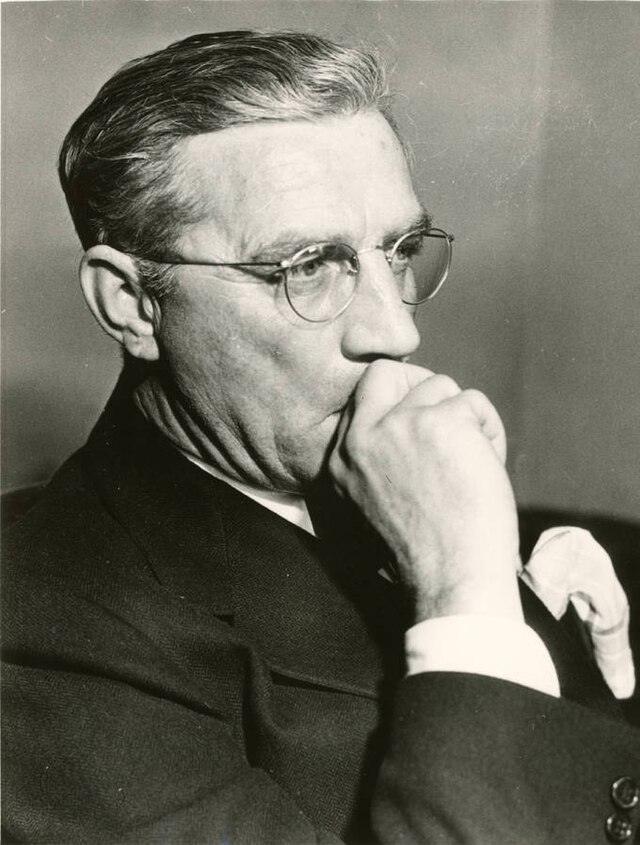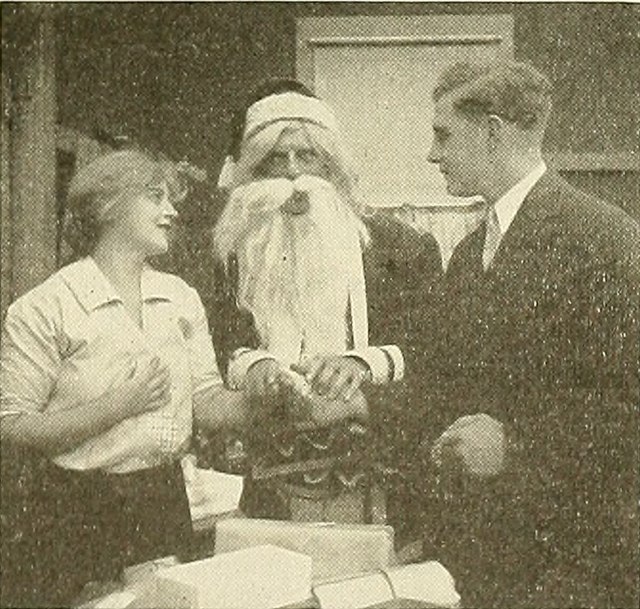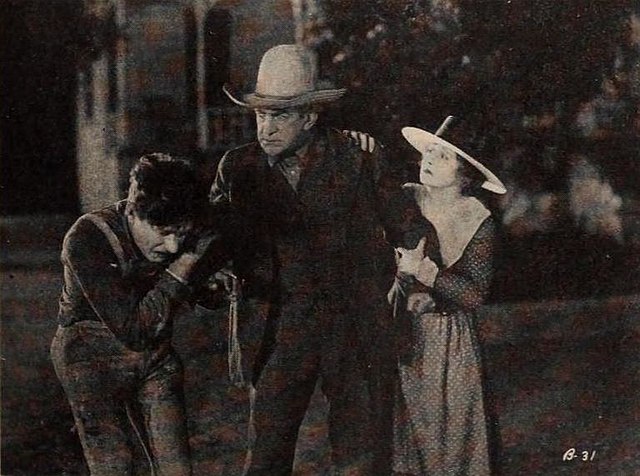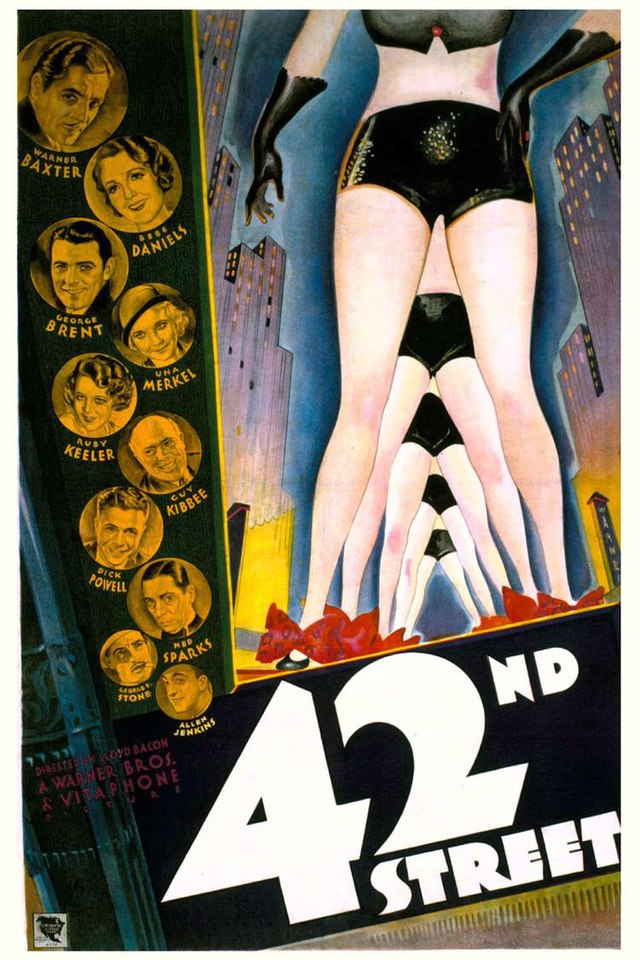Lloyd Bacon
back| Full Name | Lloyd Francis Bacon |
| Born | December 4, 1889 |
| Birthplace | San Jose, California, U.S. |
| Died | November 15, 1955 |
| Buried | Forest Lawn Memorial Park, Hollywood Hills, California |
| Married to | Margaret Adele Lowdermilk - Mary Rubey Cox - Nadine Coughlin |
| Children | Son: Frank Bacon (1937–2009); Daughter: Betsey Bacon |
| Notable films | 42nd Street (1933) - Footlight Parade (1933) - The Oklahoma Kid (1939) - Action in the Notth Atlantic (1943) |
Lloyd Bacon
A Master of Versatility in Hollywood's Golden Age
Lloyd Bacon (1889–1955) was a prolific American film director and actor, best known for his versatility during Hollywood’s Golden Age. Born in San Jose, California, into a theatrical family, Bacon started as an actor in silent films, working alongside legends like Charlie Chaplin.
Transitioning to directing in the 1920s, he became a cornerstone of Warner Bros., directing over 100 films across genres.
Related
Lloyd Bacon (1889 – 1955)
Biography and Movie Career
Lloyd Francis Bacon was a prolific American film director and actor whose career spanned the silent and golden eras of Hollywood. Born on December 4, 1889, in San Jose, California, he grew up immersed in the arts. His father, Frank Bacon, was a renowned playwright and actor, best known for the Broadway hit Lightnin' (1918). This theatrical environment undoubtedly influenced Lloyd’s path toward a life in entertainment.
Early Life and Education
Lloyd Bacon attended Santa Clara University in California, where he developed an interest in acting and stagecraft. His exposure to the performing arts led him to join David Belasco’s Los Angeles Stock Company in 1911, gaining valuable experience on stage. This was an era when theater was transitioning into the burgeoning film industry, and Bacon would find himself at the forefront of this transformation.
Military Service and Early Film Career
During World War I, Bacon served in the U.S. Navy’s photographic department, a role that deepened his technical understanding of filmmaking. After the war, he entered the film industry, initially as an actor. He appeared in several silent comedies, notably working with Charlie Chaplin in classics like The Tramp (1915) and The Champion (1915). These experiences shaped his sense of timing and visual storytelling, elements that would later define his directing style.
Transition to Directing
In the early 1920s, Lloyd Bacon began directing short comedies for Mack Sennett, gaining a reputation for his efficiency and ability to work across genres. By 1926, he had joined Warner Bros., where his career as a feature-film director took off. He directed more than 100 films during his lifetime, showcasing an impressive range of genres, from musicals and comedies to crime dramas and action films.
Career Highlights
Bacon’s most celebrated works came during the 1930s and 1940s, a period often referred to as Hollywood's Golden Age. Among his most notable films are:
• 42nd Street (1933): A groundbreaking backstage musical that revitalized the genre. Featuring choreography by Busby Berkeley, the film’s innovative style and energy became iconic.
• Footlight Parade (1933): Another Berkeley-choreographed musical that demonstrated Bacon’s ability to blend humor, drama, and spectacular visuals.
• Marked Woman (1937): A gritty crime drama starring Bette Davis and Humphrey Bogart, showcasing Bacon's knack for handling serious subject matter.
• The Oklahoma Kid (1939): A Western starring James Cagney and Humphrey Bogart, highlighting Bacon’s adaptability to different genres.
• Knute Rockne, All American (1940): A biographical sports drama featuring Ronald Reagan in one of his most memorable roles.
• Action in the North Atlantic (1943): A World War II film starring Humphrey Bogart, demonstrating Bacon’s ability to handle action-packed narratives.
Personal Life
Lloyd Bacon married three times: Margaret Adele Lowdermilk, Mary Rubey Cox, and Nadine Coughlin. He had two children, a son, Frank Bacon, who followed his father into the entertainment industry, and a daughter, Betsey Bacon. Despite his demanding career, Bacon was known to be a devoted family man who maintained strong ties to his theatrical roots.
Later Years and Legacy
Bacon continued to direct into the late 1940s and early 1950s, with notable films like It Happens Every Spring (1949). His career slowed as the studio system began to wane, but his contributions to the industry were indelible. He passed away on November 15, 1955, in Burbank, California, at the age of 65. He was laid to rest at Forest Lawn Memorial Park in Hollywood Hills, a cemetery that became the final resting place for many Hollywood legends.
In 1960, Lloyd Bacon was posthumously honored with a star on the Hollywood Walk of Fame, a fitting tribute to a director whose versatility and craftsmanship left a lasting mark on American cinema.
Video Bio on Lloyd Bacon
Summary of Lloyd Bacon’s Directing Style
Versatility and Genre Fluidity
Bacon’s hallmark was his ability to direct across a wide range of genres, including:
• Musicals (42nd Street, Footlight Parade): Known for vibrant energy and seamless integration of musical numbers with narrative. While much of the credit for choreography goes to Busby Berkeley, Bacon’s direction provided the foundation for the films’ dramatic and comedic elements.
• Crime Dramas (Marked Woman, The Oklahoma Kid): Balanced tension and character development, often focusing on moral dilemmas and personal sacrifice.
• Comedies (A Slight Case of Murder, Larceny, Inc.): Demonstrated impeccable timing, with a focus on witty dialogue and situational humor.
• War Dramas (Action in the North Atlantic, The Fighting Sullivans): Captured the heroism and camaraderie of wartime stories while emphasizing emotional depth.
This ability to pivot between genres suggests a pragmatic, unpretentious approach to storytelling.
________________________________________
Collaborative Spirit
Bacon was adept at working with the top talents of his time:
• He directed major stars like James Cagney, Bette Davis, Humphrey Bogart, and Al Jolson. His ability to manage high-profile actors and bring out memorable performances was a key strength.
• In musicals, he gave choreographers like Busby Berkeley the creative space to innovate, ensuring the overall production harmonized with the narrative.
His collaborative nature made him a trusted figure in the studio system, which demanded tight schedules and teamwork.
________________________________________
Narrative Efficiency
Bacon’s films often reflect the brisk, no-nonsense pacing typical of Warner Bros. productions in the 1930s and 1940s. This efficiency can be seen in:
• Tight storytelling: His films rarely meander, focusing on essential character arcs and plot developments.
• Economic visuals: While he wasn’t known for visual flamboyance, his films were well-crafted, with clear, dynamic compositions that served the story.
• Sharp dialogue: Many of his films relied on snappy, witty exchanges that were well-suited to the fast-talking style of stars like James Cagney.
________________________________________
Focus on Ensemble Dynamics
Bacon’s films often emphasize group dynamics and relationships:
• In musicals, ensemble casts worked together to build a sense of community and shared ambition (42nd Street, Footlight Parade).
• In crime dramas and war films, camaraderie and loyalty were recurring themes, such as the Sullivan brothers’ bond in The Fighting Sullivans or the teamwork in Action in the North Atlantic.
This focus on ensembles reflects Bacon’s understanding of human connections as central to engaging narratives.
________________________________________
Thematic Accessibility
Bacon’s films often avoided overt experimentation, favoring accessible themes and straightforward storytelling. His work resonated with audiences because:
• He addressed relatable struggles, such as ambition, redemption, love, and sacrifice.
• He often infused his films with optimism, even in darker narratives, reflecting the studio's goal of appealing to mass audiences.
________________________________________
Adaptation to the Studio System
Bacon thrived under the constraints of the studio system:
• He worked quickly and reliably, producing films that met tight deadlines without sacrificing quality.
• His lack of a distinct auteur style allowed studios to pair him with a wide variety of projects, making him one of their most dependable directors.
________________________________________
Limitations
While Bacon’s versatility was a strength, it also meant that he rarely left a distinctive personal imprint on his films. Critics often note that he was a "workmanlike" director who excelled in delivering polished, entertaining products rather than groundbreaking artistic visions. His collaborations with Busby Berkeley, for example, are more remembered for Berkeley’s choreography than Bacon’s direction.
Awards and Recognition
• Venice Film Festival:
• 1934: Nominated for the Mussolini Cup for Best Foreign Film for "Wonder Bar."
• 1937: Nominated for the Mussolini Cup for Best Foreign Film for "Marked Woman."
• Hollywood Walk of Fame:
• 1960: Posthumously awarded a star for his contributions to the motion picture industry, located at 7011 Hollywood Blvd.
Notable Quote from Lloyd Bacon:
"I see that the public gets action. Some others may use motion pictures as a vehicle for a psychological study. I haven't that patience."
This quote reflects his focus on delivering engaging, action-driven narratives that resonated with audiences.
Movies Directed by Lloyd Bacon
1926
• Broken Hearts of Hollywood: A drama exploring the personal and professional challenges faced by aspiring actors in Hollywood.
• Private Izzy Murphy: A comedy about a man who enlists in the army under a false identity, leading to a series of humorous situations.
1927
• Finger Prints: A crime drama centered on a detective using fingerprint evidence to solve a complex case.
• White Flannels: A romantic drama involving love and misunderstandings among the upper class.
• The Heart of Maryland: A historical drama set during the American Civil War, focusing on a woman's bravery.
• A Sailor's Sweetheart: A romantic comedy about a sailor's adventures and romantic entanglements.
• Brass Knuckles: A crime drama delving into the world of boxing and organized crime.
1928
• Pay as You Enter: A comedy involving mistaken identities and romantic mix-ups.
• The Lion and the Mouse: A political drama about a young woman challenging a powerful tycoon.
• Women They Talk About: A drama exploring the lives and reputations of women in society.
• The Singing Fool: A musical drama starring Al Jolson as a singer dealing with personal and professional turmoil.
1929
• Stark Mad: An adventure film set in the jungle, involving a quest for a lost city.
• No Defense: A drama about a lawyer facing moral dilemmas in a challenging case.
• Honky Tonk: A musical set in a lively nightclub, featuring romance and intrigue.
• Say It with Songs: A musical drama with Al Jolson as a singer navigating personal challenges.
• So Long Letty: A comedy about a wife swapping places with her friend to test their husbands' fidelity.
1930
• The Other Tomorrow: A drama exploring themes of love and sacrifice.
• She Couldn't Say No: A romantic comedy about a woman who can't refuse any proposal, leading to humorous situations.
• A Notorious Affair: A drama about a violinist's tumultuous love life.
• Moby Dick: An adaptation of Herman Melville's novel, focusing on Captain Ahab's obsession with the titular whale.
• The Office Wife: A drama exploring office romance and its complications.
1931
• Fifty Million Frenchmen: A musical comedy about Americans in Paris, filled with mistaken identities and romantic pursuits.
• Sit Tight: A comedy set in the world of professional wrestling, involving romance and rivalry.
• Kept Husbands: A drama about a working-class man marrying into wealth and the ensuing challenges.
• Gold Dust Gertie: A comedy about a gold-digging ex-wife causing trouble for her former husbands.
• Honor of the Family: A drama focusing on family honor and personal integrity.
• Manhattan Parade: A musical comedy set in the advertising world, featuring lively performances.
1932
• Fireman, Save My Child: A comedy about a fireman with dreams of becoming a professional baseball player.
• The Famous Ferguson Case: A crime drama about a small-town murder attracting national media attention.
• Miss Pinkerton: A mystery film featuring a nurse turned amateur detective solving a murder case.
• Crooner: A musical drama about a band's saxophonist who becomes a famous singer, leading to personal conflicts.
• You Said a Mouthful: A comedy about an inventor who creates an unsinkable swimsuit and gets involved in a swimming race.
1933
• 42nd Street: A backstage musical about the production of a Broadway show, highlighting the trials and triumphs of the cast and crew.
• Picture Snatcher: A crime drama featuring a former convict who becomes a tabloid photographer, starring James Cagney.
• Mary Stevens, M.D.: A drama about a female doctor facing professional and personal challenges in a male-dominated field.
• Footlight Parade: A musical showcasing the creation of live prologues for movies, featuring elaborate dance numbers.
• Son of a Sailor: A comedy about a sailor's misadventures and romantic pursuits.
1934
• Wonder Bar: A musical set in a Parisian nightclub, featuring intertwining romantic stories and performances.
• A Very Honorable Guy: A comedy about a gambler who sells his body to science to pay off debts, leading to humorous situations.
• He Was Her Man: A crime drama about an ex-convict seeking revenge, starring James Cagney and Joan Blondell.
• Here Comes the Navy: A comedy-drama featuring a cocky civilian who joins the Navy to win over a woman, starring James Cagney.
• 6 Day Bike Rider: A comedy about a man entering a six-day bicycle race to impress his girlfriend.
1935
• Devil Dogs of the Air: An action film about Marine pilots, focusing on their training and aerial battles, starring James Cagney.
• In Caliente: A musical set in a Mexican resort, involving romance and misunderstandings.
• Broadway Gondolier: A musical comedy about a taxi driver who becomes a radio singing sensation.
• The Irish in Us: A comedy-drama about an Irish-American family dealing with love and career conflicts, starring James Cagney.
• Frisco Kid: A crime drama about a gambler navigating the underworld of San Francisco.
1936
• Sons o' Guns: A musical comedy about a man who inadvertently becomes a war hero.
• Cain and Mabel: A romantic comedy about a struggling waitress and a prizefighter who enter into a fake romance for publicity but find themselves falling in love.
• The Singing Kid: A musical comedy starring Al Jolson as a down-on-his-luck singer who tries to revive his career.
• Love Begins at 20: A comedy about the romantic misadventures of a small-town family.
1937
• Marked Woman: A hard-hitting crime drama starring Bette Davis as a nightclub hostess who stands up to a mob boss with the help of a crusading district attorney.
• Varsity Show: A musical comedy about college students who put on a show to save their school, featuring Dick Powell and a young chorus line.
• Ever Since Eve: A romantic comedy about a secretary who disguises herself to avoid unwanted male attention, leading to hilarious consequences.
1938
• A Slight Case of Murder: A crime comedy starring Edward G. Robinson as a former bootlegger trying to go straight, only to be drawn into more trouble.
• The Amazing Dr. Clitterhouse: A crime drama-comedy about a physician who studies the psychology of criminals by joining a gang.
1939
• Indianapolis Speedway: A sports drama about two brothers competing in the dangerous world of auto racing.
• The Oklahoma Kid: A Western starring James Cagney as a charming outlaw battling corruption and injustice.
1940
• It All Came True: A crime comedy about two aspiring performers whose boarding house is taken over by a gangster.
• Knute Rockne, All American: A biographical drama about the legendary Notre Dame football coach, featuring Ronald Reagan in the iconic role of George Gipp.
1941
• Affectionately Yours: A romantic comedy about a globe-trotting reporter trying to win back his estranged wife.
• Navy Blues: A musical comedy set aboard a Navy ship, involving romantic escapades and misunderstandings.
1942
• Larceny, Inc.: A comedy about ex-convicts who buy a luggage store as a front for a bank robbery, only to become unlikely entrepreneurs.
1943
• Action in the North Atlantic: A World War II action-drama about the bravery of merchant mariners during a perilous convoy mission, starring Humphrey Bogart.
1944
• The Fighting Sullivans: A war drama based on the true story of the five Sullivan brothers, who served together on the USS Juneau during World War II.
1945
• Johnny Angel: A crime drama about a sea captain investigating the mysterious disappearance of his ship's crew.
1946
• Sentimental Journey: A tearjerking drama about a dying woman who adopts an orphan to comfort her husband after her death.
1947
• Always Together: A romantic comedy about a small-town girl who inherits a fortune and discovers that money can't buy happiness.
1948
• Wallflower: A romantic comedy about a shy woman trying to break out of her shell to win the man she loves.
1949
• It Happens Every Spring: A sports comedy about a college professor who accidentally invents a baseball that batters can’t hit.
1950
• Kill the Umpire: A baseball comedy about a man who reluctantly becomes an umpire and finds himself embroiled in hilarious situations.
1951
• The Frogmen: A World War II action-drama about a team of Navy underwater demolition experts on a dangerous mission.
1952
• We're Not Married!: A romantic comedy anthology featuring several couples dealing with marriage mix-ups.
1953
• The French Line: A musical comedy about a Texas heiress who disguises herself to find true love.
1954
• She Couldn't Say No: A romantic comedy about a wealthy woman returning to her hometown to repay its kindness, causing romantic confusion along the way.




